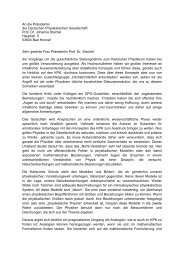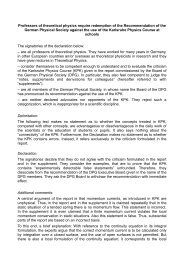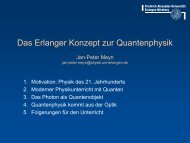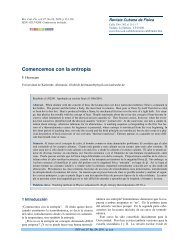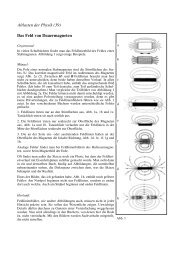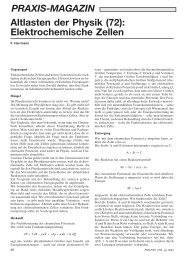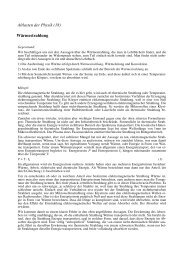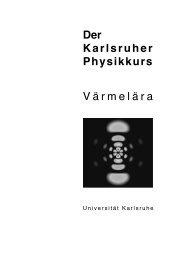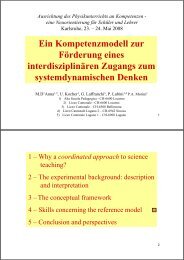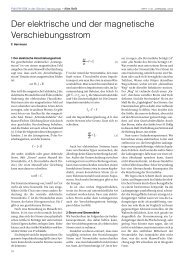Historical burdens on physics 79 Angular momentum conservation
Historical burdens on physics 79 Angular momentum conservation
Historical burdens on physics 79 Angular momentum conservation
Create successful ePaper yourself
Turn your PDF publications into a flip-book with our unique Google optimized e-Paper software.
<str<strong>on</strong>g>Historical</str<strong>on</strong>g> <str<strong>on</strong>g>burdens</str<strong>on</strong>g> <strong>on</strong> <strong>physics</strong><br />
<strong>79</strong> <strong>Angular</strong> <strong>momentum</strong> c<strong>on</strong>servati<strong>on</strong><br />
Subject:<br />
The law of c<strong>on</strong>servati<strong>on</strong> of angular <strong>momentum</strong> is often introduced as follows:<br />
We c<strong>on</strong>sider a mass point. We write the cross product of the vector<br />
<strong>on</strong> both sides of Newt<strong>on</strong>’s sec<strong>on</strong>d law<br />
F = dp/dt<br />
and the positi<strong>on</strong> vector r (relative to an arbitrarily chosen origin). We get a<br />
relati<strong>on</strong> between the torque and the time rate of change of the angular <strong>momentum</strong>:<br />
M = dL/dt .<br />
We write the corresp<strong>on</strong>ding expressi<strong>on</strong> for two or more mass points and<br />
take into account that for the internal interacti<strong>on</strong> forces there is<br />
Fik = – Fki ,<br />
and that these forces are parallel to ri – rk . We then find that the time derivative<br />
of the angular <strong>momentum</strong> of the system of mass points is equal to<br />
the sum of the torques of the external forces. From this follows the law of<br />
angular <strong>momentum</strong> c<strong>on</strong>servati<strong>on</strong>: “The angular <strong>momentum</strong> of a system remains<br />
c<strong>on</strong>stant, if no external torque acts <strong>on</strong> the system.”<br />
Deficiencies:<br />
Our foregoing derivati<strong>on</strong> of the angular <strong>momentum</strong> c<strong>on</strong>servati<strong>on</strong> is somewhat<br />
short, since we believe that it is known to the reader. In a text book it<br />
easily needs an entire page with about 10 lines of equati<strong>on</strong>s. It is not hard<br />
to follow such a derivati<strong>on</strong> step by step, and at the end, the student will<br />
probably be c<strong>on</strong>vinced that the law of <strong>momentum</strong> c<strong>on</strong>servati<strong>on</strong> must be<br />
valid. However if we ask the student, what actually has been proven <strong>on</strong> this<br />
page, he or she might run into trouble. The derivati<strong>on</strong> starts with Newt<strong>on</strong>’s<br />
sec<strong>on</strong>d law, which is equivalent to the law of <strong>momentum</strong> c<strong>on</strong>servati<strong>on</strong>, and<br />
the result of the calculati<strong>on</strong> is the law of angular <strong>momentum</strong> c<strong>on</strong>servati<strong>on</strong>.<br />
It is unavoidable that the student believes, angular <strong>momentum</strong> c<strong>on</strong>servati<strong>on</strong><br />
has been mathematically derived from <strong>momentum</strong> c<strong>on</strong>servati<strong>on</strong>. It is needless<br />
to say that this is not true. There will hardly be a student who understands<br />
the trick that was employed.<br />
They will even not suspect that there<br />
was a trick. Actually, in the above derivati<strong>on</strong><br />
angular <strong>momentum</strong> c<strong>on</strong>servati<strong>on</strong><br />
is not derived from <strong>momentum</strong><br />
c<strong>on</strong>servati<strong>on</strong>, but angular <strong>momentum</strong><br />
c<strong>on</strong>servati<strong>on</strong> is fed into the calculus<br />
when saying that the forces Fik and Fki<br />
are parallel to ri – rk .<br />
Fig. 1 shown something that does not<br />
exist in reality. Two bodies exert forces<br />
<strong>on</strong> <strong>on</strong>e another, that are equal and of<br />
opposite directi<strong>on</strong> (F12 = – F21), but<br />
which are not parallel to ri – rk . They<br />
obey Newt<strong>on</strong>’s third law and thus mo-<br />
Fig. 1. The forces <strong>on</strong> both bodies are<br />
not parallel to the straight line between<br />
the bodies. Thus, the law of angular<br />
<strong>momentum</strong> c<strong>on</strong>servati<strong>on</strong> is not obeyed.
mentum c<strong>on</strong>servati<strong>on</strong>, but since they are equivalent to a torque, the angular<br />
<strong>momentum</strong> of the system should increase, and it would do so without an<br />
external torque. But there are no such forces. They are forbidden by the law<br />
of angular <strong>momentum</strong> c<strong>on</strong>servati<strong>on</strong>. Thus the claim that Fik and Fki are parallel<br />
to ri – rk is equivalent to the claim that angular <strong>momentum</strong> is a c<strong>on</strong>served<br />
quantity.<br />
In summary, a somewhat lengthy calculati<strong>on</strong> is carried out, into which angular<br />
<strong>momentum</strong> c<strong>on</strong>servati<strong>on</strong> is injected, and at the end, <strong>on</strong>e is happy that<br />
the law of angular <strong>momentum</strong> c<strong>on</strong>servati<strong>on</strong> comes out. But why then the<br />
calculati<strong>on</strong>?<br />
Origin:<br />
Newt<strong>on</strong>’s laws c<strong>on</strong>tain not more and not less than <strong>momentum</strong> c<strong>on</strong>servati<strong>on</strong>.<br />
Due to their great success the idea has spread that they are more than just<br />
a simple c<strong>on</strong>servati<strong>on</strong> law. They seem to be the be-all and the end-all of<br />
<strong>physics</strong>, the basis from which everything else can be derived. Sometimes,<br />
even energy c<strong>on</strong>servati<strong>on</strong> is derived from Newt<strong>on</strong>’s laws – again with a<br />
trick.<br />
Disposal:<br />
Introduce angular <strong>momentum</strong> as a quantity of its own right, for which a c<strong>on</strong>servati<strong>on</strong><br />
law is valid. This does not exclude to show how the angular <strong>momentum</strong><br />
of a system of mass points is related to the momenta of its c<strong>on</strong>stituents.<br />
Friedrich Herrmann, Karlsruhe Institute of Technology





